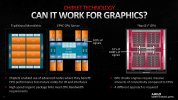Frenetic Pony
Veteran
Known:
This year
GDDR7
Raytracing Traversal (similar performance to Intel/Nvidia)
Powerdraw is fixed, very high clockspeeds
Leaked?(by you know who, plus some dumb AMD engineer on a youtube comment)
Announcement in H1, maybe Computex
Big chip is in this time, likely stacked SRAM and such
Big chip is really expensive, stupid big, tons of power draw, there solely for PR purposes, >$1k
$1k >= chip is more mainstream high end.
This year
GDDR7
Raytracing Traversal (similar performance to Intel/Nvidia)
Powerdraw is fixed, very high clockspeeds
Leaked?(by you know who, plus some dumb AMD engineer on a youtube comment)
Announcement in H1, maybe Computex
Big chip is in this time, likely stacked SRAM and such
Big chip is really expensive, stupid big, tons of power draw, there solely for PR purposes, >$1k
$1k >= chip is more mainstream high end.




